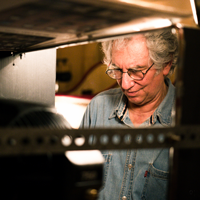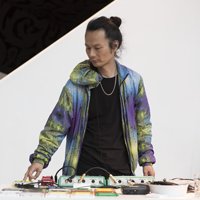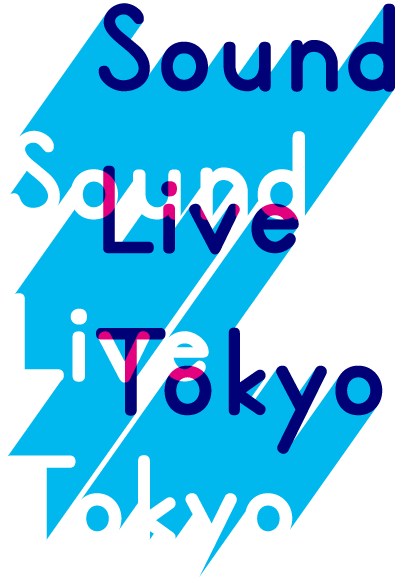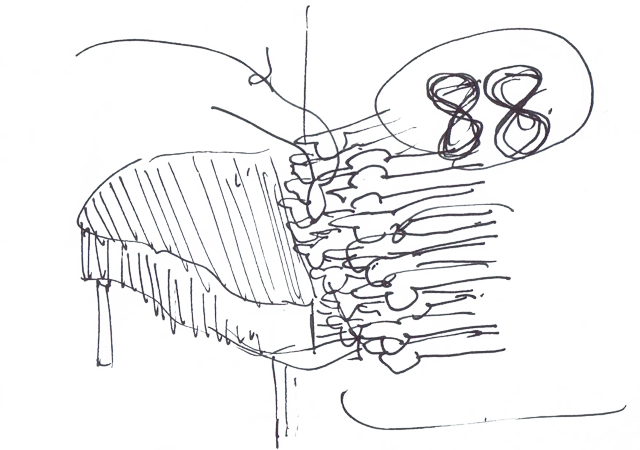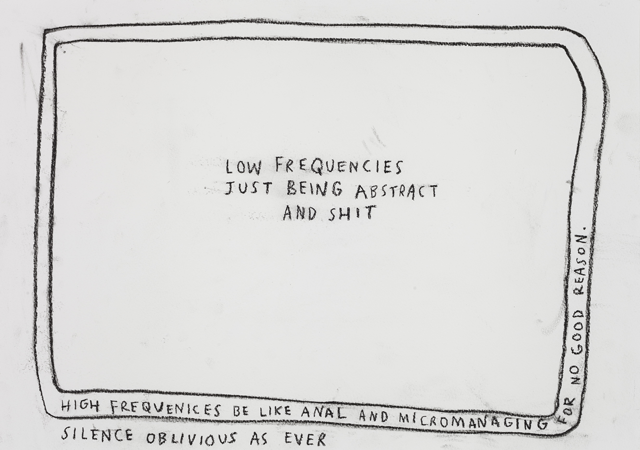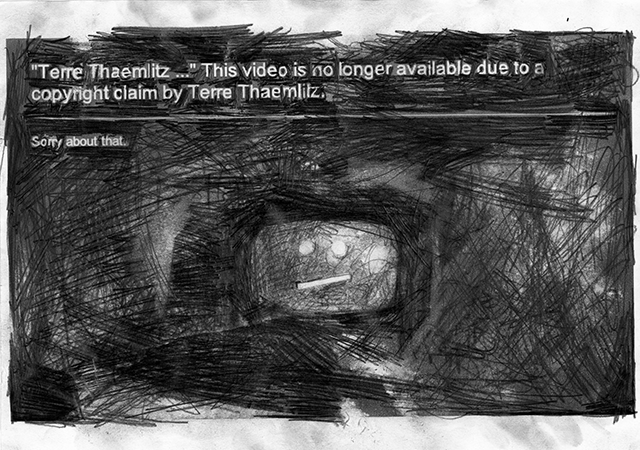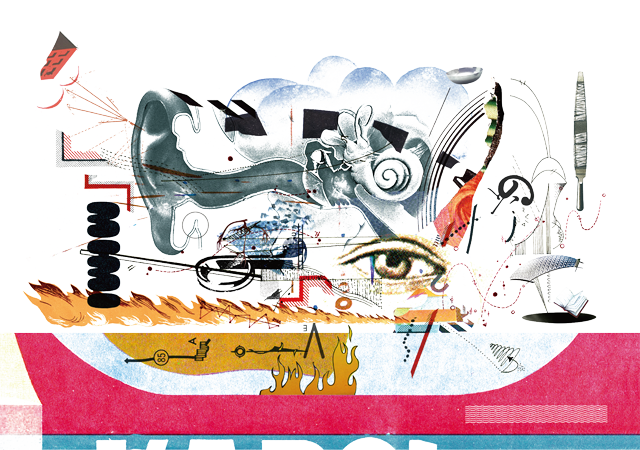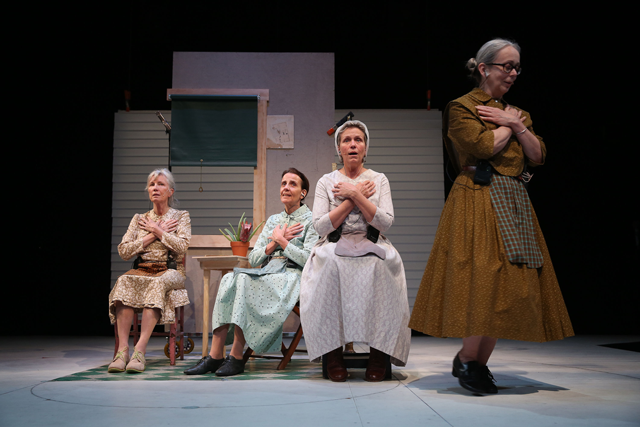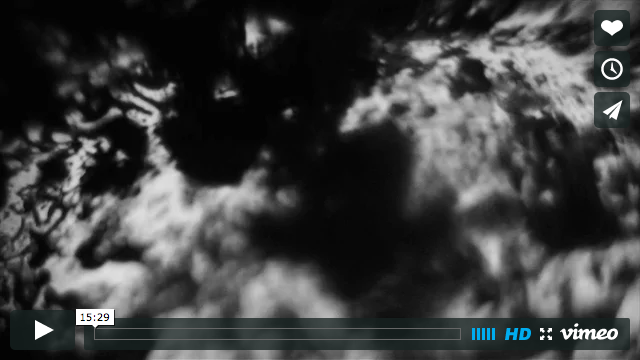
Nervous Magic Lantern
Projections by Ken & Flo Jacobs
Sounds by Aki Onda
Stage manager: So Ozaki
Sound: Toshihiko Kasai
Equipment and construction: Yoshihiro Yoshida (EdithGrove Co., Ltd.), Hiroki Ura (Stage Work URAK Co.,Ltd.)
Documentation: Masato Hara (sound), Kenta Matsuo (video), Hideto Maezawa (photo)
Tuesday (national holiday), November 3 | 18:30 open, 19:00 start
*Related screenings: Saturday, October 17 – Saturday, October 31
Adv 2,500 yen / Door 3,000 yen
Advance tickets available at Peatix
A political landscape in 3D that emerges from the magic lantern without film/video and the sound of “daily life”
Aki Onda, known for his Cassette Memories that sound as if summoning up the essence of memories through field recordings, was originally a photographer and was influenced by filmmakers such as Jonas Mekas already in his teenage. He frequently visited New York to explore experimental films, and finally settled there. Since then, he has built friendships with filmmakers beyond generations (his trio with Michael Snow and Alan Licht is one of the results). Nervous Magic Lantern is a live screening performance by Ken Jacobs, the filmmaker for whom Onda has the greatest admiration. Jacobs, with his partner Flo, delivers 3D images manually operating a self-made projector without film or video. The 3D effects are created through flickers and parallax, and do not require special glasses. Onda has been on the sound component of the project since 2007.
Compared to Jacobs’ films, which are full of blunt political criticism, the 3D images of Nervous Magic Lantern are apparently abstract. However, the images directly interfere in the ideologies that regulate our perceptions. “We’re stepping towards a deeper incline, something challenging our notion of the way things are. Something impossible” (Jacobs [1]). Jacobs, who is not in favor of the artificiality of studio recording, requested Onda to play the “sounds of daily life.” The invention, piece or performance called Nervous Magic Lantern has been improving since the 1990s, involving John Zorn and many other musicians. Now with Onda, who connects sounds to “something bigger, instead of depicting daily life or just treating all the sounds equally, to materialize our lives themselves as art,” the project is at the peak of its evolution.
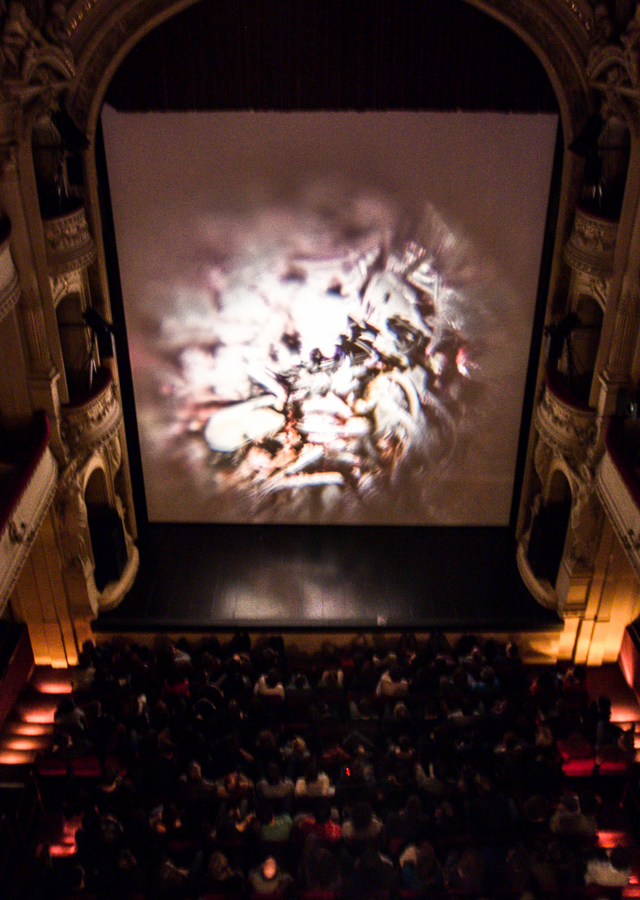 ©Michiel Devijver
©Michiel Devijver
Compared to Jacobs’ films, which are full of blunt political criticism, the 3D images of Nervous Magic Lantern are apprently abstract. However, the images directly interfere in the ideologies that regulate our perceptions. “We’re stepping towards a deeper incline, something challenging our notion of the way things are. Something impossible” (Jacobs [1]). Jacobs, who is not in favor of the artificiality of studio recording, requested Onda to play the “sounds of daily life.” The invention, piece or performance called Nervous Magic Lantern has been improving since the 1990s, involving John Zorn and many other musicians. Now with Onda, who connects sounds to “something bigger, instead of depicting daily life or just treating all the sounds equally, to materialize our lives themselves as art,” the project is at the peak of its evolution.
So now I can answer what Ken Jacobs’ art is all about: It’s about happiness. [...] His shapes and forms transmit to us, evoke in us or rather produce in us the states and forms of radiance. You can feel happiness moving through you. Not an ignorant, fool’s happiness, but a happiness of one who is totally awake. Happiness in full consciousness. That’s the difference between art and LSD.
Jonas Mekas [1]
The video recording and photo above can never convey the experience of the “depth” in this performance. Please witness the primitive and advanced “magic lantern” projections that epitomize Jacobs’ 60-year career of redefining the history of cinematic expressions and techniques, from the early cinema to digital and 3D technologies, at his first visit to Japan in 22 years at the age of 82.
*Please note that the entire performance involves flickers.
Related Screenings (co-organized with Image Forum)
Star Spangled to Death (1956–60/2003–04, 440 min.) and selected works
Saturday, October 17 – Saturday, October 31
Adv 1,200 yen – 2,300 yen / Door 1,100 yen – 2,500 yen
*Ken Jacobs’ greeting before the screening on Saturday, October 31 planned
Detailed schedule and prices
Advance tickets available at Peatix
*Ken Jacobs’ greeting before the screening on Saturday, October 31 planned
Detailed schedule and prices
Star Spangled to Death
1956–60/2003–04, digital, 440 min.
An epic film consisting of anarchic street theatre, found-footage and enormous flow of text that critically reflects on the history of the United States and vision of the post-9/11 world. One of the monuments of experimental cinema that exhibits Jacobs’ creative, technical, joyous and furious explorations for 50 years. All-night, 440-minute screenings with some breaks.
*3D glasses not required. Note that the film involves flickers.
Two Wrenching Departures
1989/2006, digital, 90 min.
One of the most beautiful 3-D works by Jacobs that mourns for Jack Smith and Bob Fleischner, his friends (and performers in Star Spangled to Death) who passed away within one week of each other in 1989. It was premiered as a “Nervous System” performance, where two identical prints on two projectors in various degrees of synchronization would create 3-D illusions.
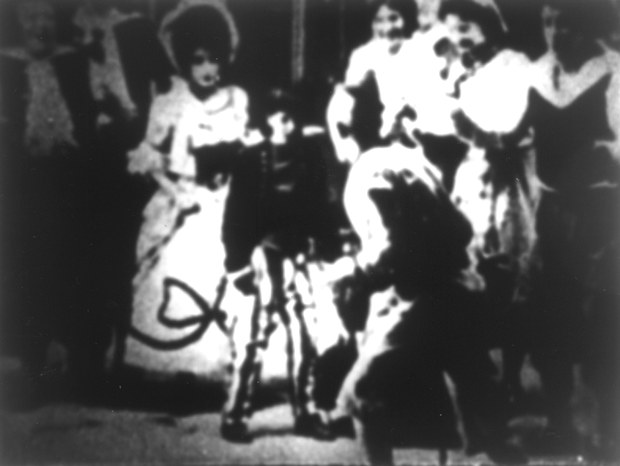
Tom, Tom, the Piper’s Son
1969–71, 16mm, 115 min.
A masterpiece of what was termed “structural film” that samples and remixes the eponymous, single-scene early film based on a Mother Goose rhyme (8 min, director unknown), which was rescued and restored via a paper print, for two hours and draws an extreme amount of information hidden in the forgotten film.
*3D glasses not required. Note that the film involves flickers.
Return to the Scene of the Crime
2008, digital, 93 min.
About 100 years after the “original” (1905), this work accelerates the approach of Tom, Tom, the Piper’s Son (1969–71) in digital 3D to cast lights from all the angles on the “crime” (Tom, Tom, the piper’s son, stole a pig, and away did run...) and hundreds of actions that coincide with it. An aggressive and rapturous ode to cinema.

Star Spangled to Death
1956–60/2003–04, digital, 440 min.
An epic film consisting of anarchic street theatre, found-footage and enormous flow of text that critically reflects on the history of the United States and vision of the post-9/11 world. One of the monuments of experimental cinema that exhibits Jacobs’ creative, technical, joyous and furious explorations for 50 years. All-night, 440-minute screenings with some breaks.
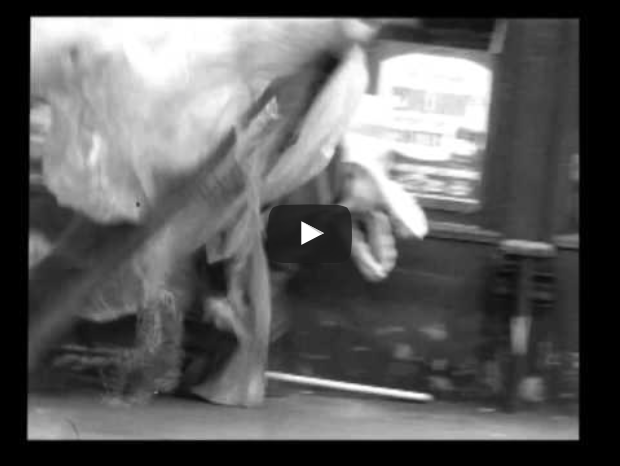
*3D glasses not required. Note that the film involves flickers.
Two Wrenching Departures
1989/2006, digital, 90 min.
One of the most beautiful 3-D works by Jacobs that mourns for Jack Smith and Bob Fleischner, his friends (and performers in Star Spangled to Death) who passed away within one week of each other in 1989. It was premiered as a “Nervous System” performance, where two identical prints on two projectors in various degrees of synchronization would create 3-D illusions.

Tom, Tom, the Piper’s Son
1969–71, 16mm, 115 min.
A masterpiece of what was termed “structural film” that samples and remixes the eponymous, single-scene early film based on a Mother Goose rhyme (8 min, director unknown), which was rescued and restored via a paper print, for two hours and draws an extreme amount of information hidden in the forgotten film.
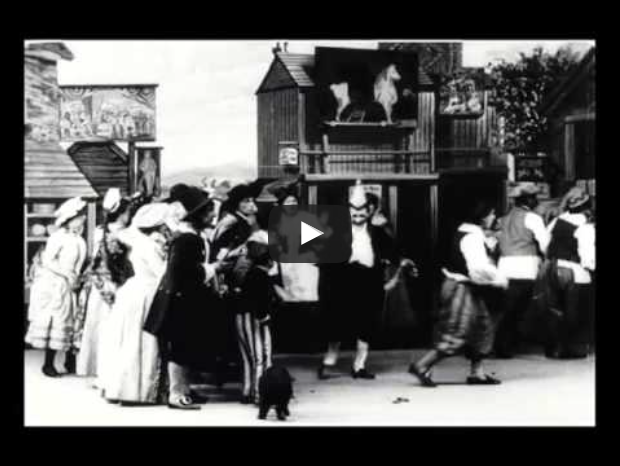
*3D glasses not required. Note that the film involves flickers.
Return to the Scene of the Crime
2008, digital, 93 min.
About 100 years after the “original” (1905), this work accelerates the approach of Tom, Tom, the Piper’s Son (1969–71) in digital 3D to cast lights from all the angles on the “crime” (Tom, Tom, the piper’s son, stole a pig, and away did run...) and hundreds of actions that coincide with it. An aggressive and rapturous ode to cinema.
Star Spangled to Death
(1956–60/2003–04, digital, 440 min.)
An epic film consisting of anarchic street theatre, found-footage and enormous flow of text that critically reflects on the history of the United States and vision of the post-9/11 world. One of the monuments of experimental cinema that exhibits Jacobs’ creative, technical, joyous and furious explorations for 50 years. All-night, 440-minute screenings with some breaks.
*3D glasses not required. Note that the film involves flickers.
Two Wrenching Departures
(1989/2006, digital, 90 min.)
One of the most beautiful 3-D works by Jacobs that mourns for Jack Smith and Bob Fleischner, his friends (and performers in Star Spangled to Death) who passed away within one week of each other in 1989. It was premiered as a “Nervous System” performance, where two identical prints on two projectors in various degrees of synchronization would create 3-D illusions.

Tom, Tom, the Piper’s Son
(1969–71, 16mm, 115 min.)
A masterpiece of what was termed “structural film” that samples and remixes the eponymous, single-scene early film based on a Mother Goose rhyme (8 min, director unknown), which was rescued and restored via a paper print, for two hours and draws an extreme amount of information hidden in the forgotten film.
*3D glasses not required. Note that the film involves flickers.
Return to the Scene of the Crime
(2008, digital, 93 min.)
About 100 years after the “original” (1905), this work accelerates the approach of Tom, Tom, the Piper’s Son (1969–71) in digital 3D to cast lights from all the angles on the “crime” (Tom, Tom, the piper’s son, stole a pig, and away did run...) and hundreds of actions that coincide with it. An aggressive and rapturous ode to cinema.
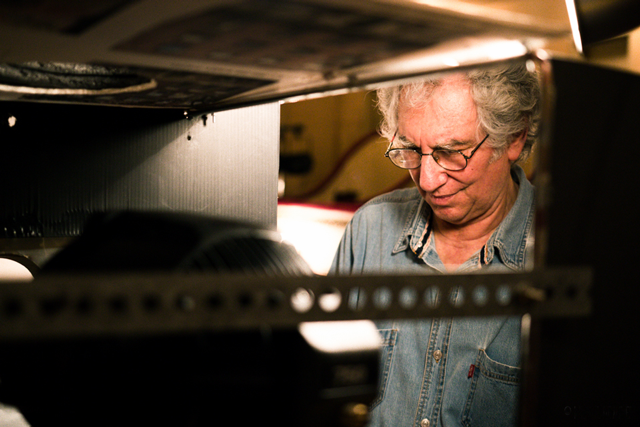 ©Michiel Devijver
©Michiel Devijver
Ken Jacobs | He began working in a mode of guerrilla cinema, shooting anarchic and exuberant — yet also politically astute — theatrics in the streets of his native New York in the early 1950s. Fascinated with early cinema and experimental film from a young age, Jacobs gradually turned to found footage as a dominant inspiration, a breakthrough marked by his seminal deconstruction of cinematic narrative and illusionism Tom, Tom the Piper’s Son (1969), which famously manipulates and expands a 1905 film of the same name to create a breathless and revelatory work of pure cinema. Early “primitive” cinema, and increasingly, nineteenth century photography, has remained a touchstone in Jacobs’ work and a principal tool to launch an extended critique of the aesthetic, ideological and technological limits defining film and the cinematic apparatus itself. Endlessly curious about technology, Jacobs embraced the possibilities of video in a meeting of the digital, early film/photography and 3-D imagery that magically bridges the 19th and 21st centuries.
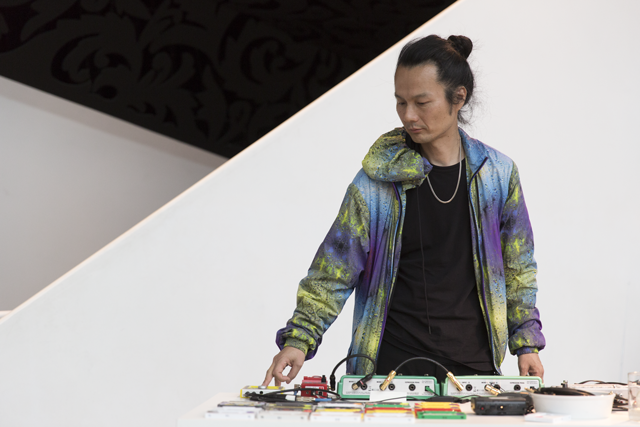 Photo by Heidi Bohnenkamp
Photo by Heidi Bohnenkamp
Aki Onda | An electronic musician, composer, and visual artist. Onda was born in Nara, Japan and currently resides in New York. He is particularly known for his Cassette Memories project — works compiled from a “sound diary” of field-recordings collected by Onda over a span of two decades. Onda’s musical instrument of choice is the cassette Walkman. Not only does he capture field recordings with the Walkman, he also physically manipulates multiple Walkmans with electronics in his performances. In recent years, Onda often works in interdisciplinary fields and collaborates with filmmakers, choreographers and visual artists. Onda has collaborated with artists such as Michael Snow, Ken Jacobs, Raha Raissinia, Paul Clipson, Alan Licht, Loren Connors, Akio Suzuki, Sei Miguel, Noël Akchoté, Jean-François Pauvros, Jac Berrocal, Lionel Marchetti, Linda Sharrock, and Blixa Bargeld.
*1 Jonas Mekas, Movie Journal: The Rise of a New American Cinema, 1959-1971, p. 351, Collier Books, 1972
